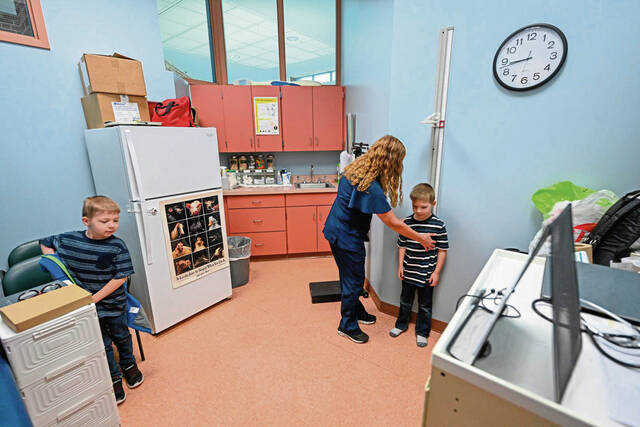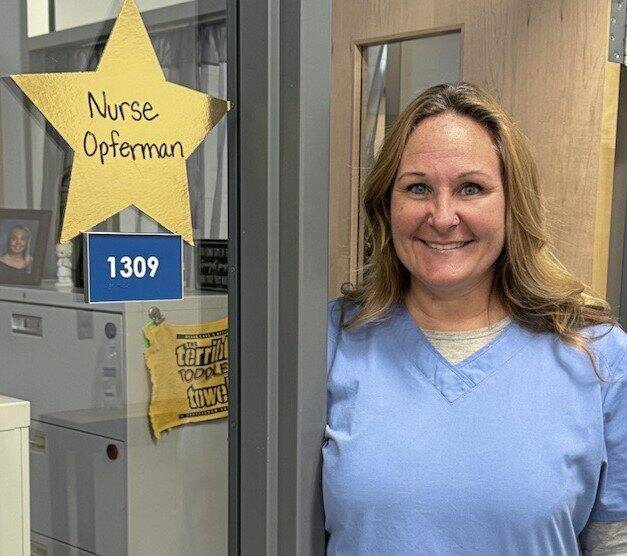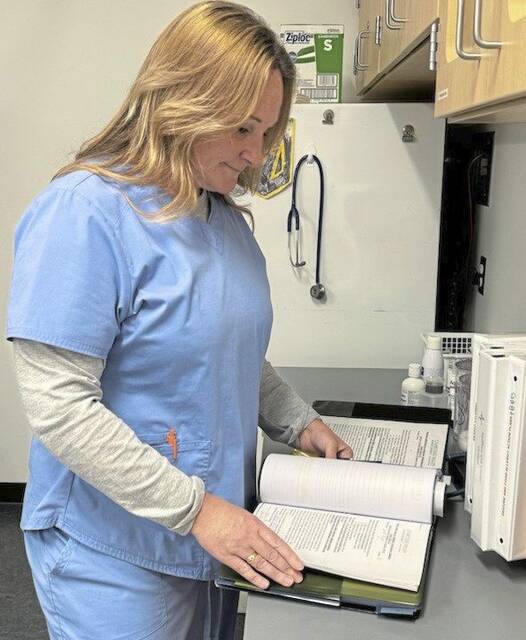Schools battle national shortages, pay disparity to keep nurses on the job
Aliza Zelina arrives for her school nursing job at Highlands Middle School in Harrison just after 7 a.m. each day knowing she won’t have much prep time before her patients begin to roll in.
“We see kids bright and early,” she said. “It’s steady, seeing about 50 to 60 visits a day. Throughout the day, it’s more scheduled care, with about 20 medical visits.”
Across the region, school nurses say their job responsibilities have expanded from skinned knees to overseeing a variety of health issues ranging from managing students’ diabetes and other chronic ailments to offering mental health support and even serving as the de facto primary health care provider for students who don’t regularly see a family doctor.
While the responsibilities grow, the number of school nurses is shrinking, which is attributed to an overall loss of nurses nationwide and lower pay that’s typical for school nurses when compared with their counterparts in hospitals or other health care facilities.
It’s a situation that has some school districts using outside nursing agencies to provide temporary help and fill gaps.
A 2021 workforce study, conducted by the National Association of School Nurses, found about 66% of schools have access to a full-time school nurse, defined as working more than 35 hours a week. There are about 8% of schools that have access to only a licensed practical nurse or licensed vocational nurse. About 6% of schools do not have access to a nurse at all.
That leaves about a fifth of schools nationwide with nurses split among buildings, traveling around a district to serve students.
Declining numbers
“Before covid, people would say there’s a shortage of school nurses, and I’d say, ‘No, there’s a shortage of districts willing to pay nurses enough to work there,’ ” said Kate King, president of the National Association of School Nurses and a public school nurse in Columbus, Ohio. “Now, there’s a worldwide shortage of nurses. We are having difficulty across the country.”
There are 4 million nurses in the U.S., but that’s 78,000 nurses shy of what will be needed by next year, according to a study by the federal Health Resources and Services Administration. Even with expected increases in the number of nurses graduating from college, that shortage is expected to still be almost 64,000 by 2030.
The largest loss of nurses happened during the covid-19 pandemic. About 100,000 nurses left the profession between 2020 and 2021, according to a nationwide study reported in the publication Health Affairs.
All of this means school districts often have trouble keeping adequate numbers of nurses on staff.
Zelina, who is in her third year as a school nurse after working in a hospital, said Highlands staffs one nurse in each of its three buildings. Still, she said, there was difficulty in getting some positions filled last year.
Chartiers Valley School District can attest to the shortage. Hiring school nurses had not been a problem until this year, Assistant Superintendent Julie Franczyk said.
At Chartiers Valley, a certified school nurse is assigned to each of the district’s four buildings, but two nurses resigned over the summer and the district so far has managed to fill just one of those positions, Franczyk said.
“The perception is our job is easy whereas, in reality, it’s not,” said Michelle Opferman, a 24-year nurse, with the past 18 as a school nurse at Chartiers Valley High School and the district’s head nurse. “It’s a special thing that you have to be certified for and interested in.”
Franczyk said her district has used a third-party service for the past few years as backups but wants to hire full-time, district-employed nurses. Having a full-time nurse provides more consistent care and is more cost effective, she said.
Opferman said third-party nurses do a great job on day-to-day work, but it’s up to the certified school nurse to handle things such as paperwork and immunizations. Relying on agency nurses is “like a music teacher filling in for a social studies class,” she said.
The Derry Area School District is having trouble finding substitute nurses who can step into a school nurse’s role.
“Due to a shortage of substitute nurses over the past several years, we have had to utilize staffing agencies to fill substitute nursing vacancies and address special student needs,” said Casey Long, Derry’s assistant superintendent.
North Hills School District also is down nurses, according to Alisha Ravenstahl, the district’s head nurse.
The district staffs one certified school nurse in each building and also has support nurses and a third-party health care contractor. North Hills is looking to hire a long-term substitute certified school nurse and a support nurse.
“It’s kind of been constant for the past couple years as far as hiring and retaining,” Ravenstahl said. “It’s definitely a tricky thing to navigate.”
Mt. Pleasant Area School District has three certified school nurses to cover four buildings.
Donegal Elementary, which has just 87 students enrolled in grades K-3, is staffed by a nurse’s aide. To provide required oversight of student care, the aide trades places at least once a week with a certified nurse at Norvelt Elementary, according to Assistant Superintendent Beth Hutson.
The nurse at Norvelt is the third to hold that position in as many years, Hutson said, adding that the district has been stymied in trying to fill an additional nurse’s aide slot.
“We have advertised using every venue possible, and we still have not found one,” Hutson said. “We’ve had some wonderful candidates, but then they find out what the wage is. They can make substantially more in the medical field.”
Overcoming a pay gap
Salary is a big factor when it comes to the struggle of filling vacancies, said King of the National Association of School Nurses. She said school nurses are paid significantly less — as much as $10,000 to $40,000 less per year — than nurses with the same education and licensing who work at a hospital or health care facility.
“Nurses in every specialty are leaving the profession because of the difficult experiences in their work life and their pay as well,” King said.
In Pennsylvania, the average pay for a registered nurse is about $44 per hour, according to job search site Indeed.com. For certified school nurses, the average is $34 per hour. Salary.com shows the median registered nurse salary in Pennsylvania is about $71,000 per year, while the median for school nurses is only a little more than $56,000 per year.
Despite the lower overall pay, certified school nurses need more training than registered nurses.
To be a certified school nurse in Pennsylvania generally requires being a registered nurse and also completing an approved school nurse pre-K to 12th grade certificate program. That means taking about a year’s worth of additional classes after earning a nursing license.
At the University of Pittsburgh, for example, the program consists of 15 college credits offered in three sessions to qualify for the school nurse certification from the state Department of Education. Such programs normally are available only to those who already have earned a bachelor’s degree in nursing. In addition to the classwork, candidates for a school nurse certificate also must put in 120 hours working with a licensed school nurse in a school setting.
The need for additional certifications to be a school nurse can be a deterrent. Nurses in a hospital, for example, might not want to spend the money for those qualifications to, in many cases, take a pay cut to work in a school.
Jen Hunker, the certified school nurse at Mt. Pleasant Area Junior-Senior High, took a pay cut when she moved from working in a hospital to serving as a school nurse in 2008.
The Burrell School District increased its rate for health office nurses by $3 — to a rate of $23 per hour — in an effort to retain those employees, Superintendent Shannon Wagner said. The certified school nurses at Burrell, as in many other districts, are included under the district’s teacher contract, she said.
Hutson said Mt. Pleasant Area is considering increasing its hourly pay for a licensed practical nurse from $18 to $20 per hour.
Similar is the case at Chartiers Valley.
“The nurses — this is not unique to Chartiers Valley — they’re part of our teachers union, or collective bargaining unit,” Franczyk said. “For (the teacher’s union,) they’re part of that, so they follow the same pay scale as our teaching staff.”
Opferman said school nursing is something not a lot of undergraduate programs offer. Instead, the field is something people have to know about and choose to pursue.
Ravenstahl recommends a certified school nurse have experience elsewhere in the health care field before becoming a school nurse because they generally work alone in the schools.
“The pay is good and competitive for the education world,” Franczyk said. “But it doesn’t compare to the health care field.”
Expanding role
The nation’s first school nurse, Lina Rogers Struthers, was hired in the New York City school system in 1902 in an experiment to reduce health-related chronic absenteeism, King said. That’s still something school nurses handle today — along with much more.
School nurses are the “chief wellness officer” of a school, and districts need to recognize that, King said.
“It varies greatly from district to district and state to state how school nurses are treated in schools,” King said. “School nurses are a part of the professional education team. We remove barriers to health care so students can be in school.”
At Burrell, certified school nurses ensure students are up to date on immunizations, meet with parents about medical concerns, create care plans and administer screenings, according to Patty White, a certified school nurse at Burrell for the past 22 years.
“Our students have a lot more health needs. When I first started, what we were seeing were headaches, bellyaches, general illness. Now, kids are coming to us with significant health issues. They’re requiring more medications and daily insulin,” White said.
Burrell has two certified school nurses and two health office nurses, a model the district has used since the 2012-13 school year, Wagner said. The district found it to be more efficient than its prior model of three certified school nurses for four buildings.
A certified school nurse and a health office nurse are assigned to the district’s high school and middle school. They rotate schedules, so one spends a day at one building while the other is assigned to the other building.
The other certified school nurse and health office nurse do the same at the district’s elementary buildings.
Ravenstahl, who started at North Hills in 2017, estimated a daily visit load of about 60 to 70 children at that time. Today, that number has doubled to about 150 children per day, she said.
Reasons for visits run the gamut, from dealing with chronic illnesses such as diabetes and seizures to everyday maladies such as headaches and fevers to handling paperwork related to immunizations and screenings.
“The perception is our job is just Band-Aids. That’s the furthest from the truth,” said Opferman at Chartiers Valley.
A calling
Building a rapport with students and helping them address their health needs can sometimes take a toll on a nurse, Ravenstahl said, because they’re invested in students’ health and success.
“Ultimately, that’s what we’re here for, making sure the kids are safe and the staff’s safe and that we’re giving everyone the best care we can,” Ravenstahl said.
Derry’s Long says his district is grateful for the work of its nurses.
“Their commitment ensures that the health and well-being of our students remain a top priority,” Long said.
At Highlands, Zelina is the primary health care provider for some students.
“For me, personally, it suits my personality the best,” Zelina said of being a school nurse. “Not only do I love health care-related science and nursing, I love teaching. So it’s the best of both worlds.”
Being a school nurse, with steady hours and summers off, can be attractive compared to the rigors of being a hospital nurse, often working weekends, overnight shifts and holidays.
As a mother, Opferman said she’s able to balance spending weekends and summers with her children while also being able to work. “It’s definitely a speciality,” she said. “You might make more money other places, but the benefits are much greater.”
Being a school nurse is a tough but rewarding job, White said.
“We see the kids come through as kindergartners — and knowing the health issues they’re dealing with — and getting to see them graduate and move on as adults. It’s rewarding to see them do that,” White said. “I feel most people who get on, stay on until we retire.”
Kellen Stepler is a TribLive reporter covering the Allegheny Valley and Burrell school districts and surrounding areas. He joined the Trib in April 2023. He can be reached at kstepler@triblive.com.
Remove the ads from your TribLIVE reading experience but still support the journalists who create the content with TribLIVE Ad-Free.






